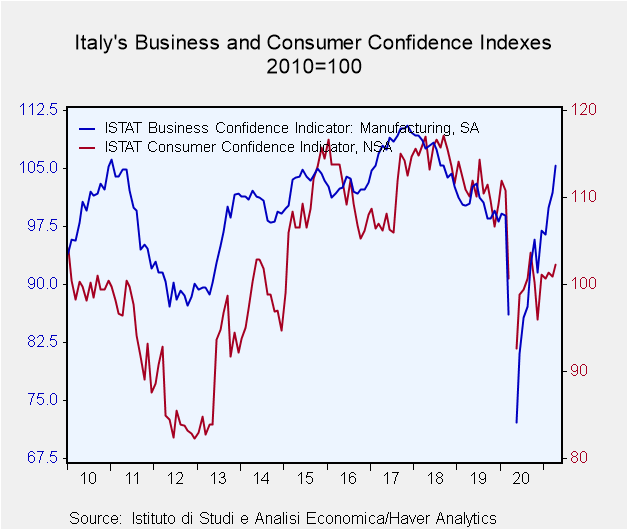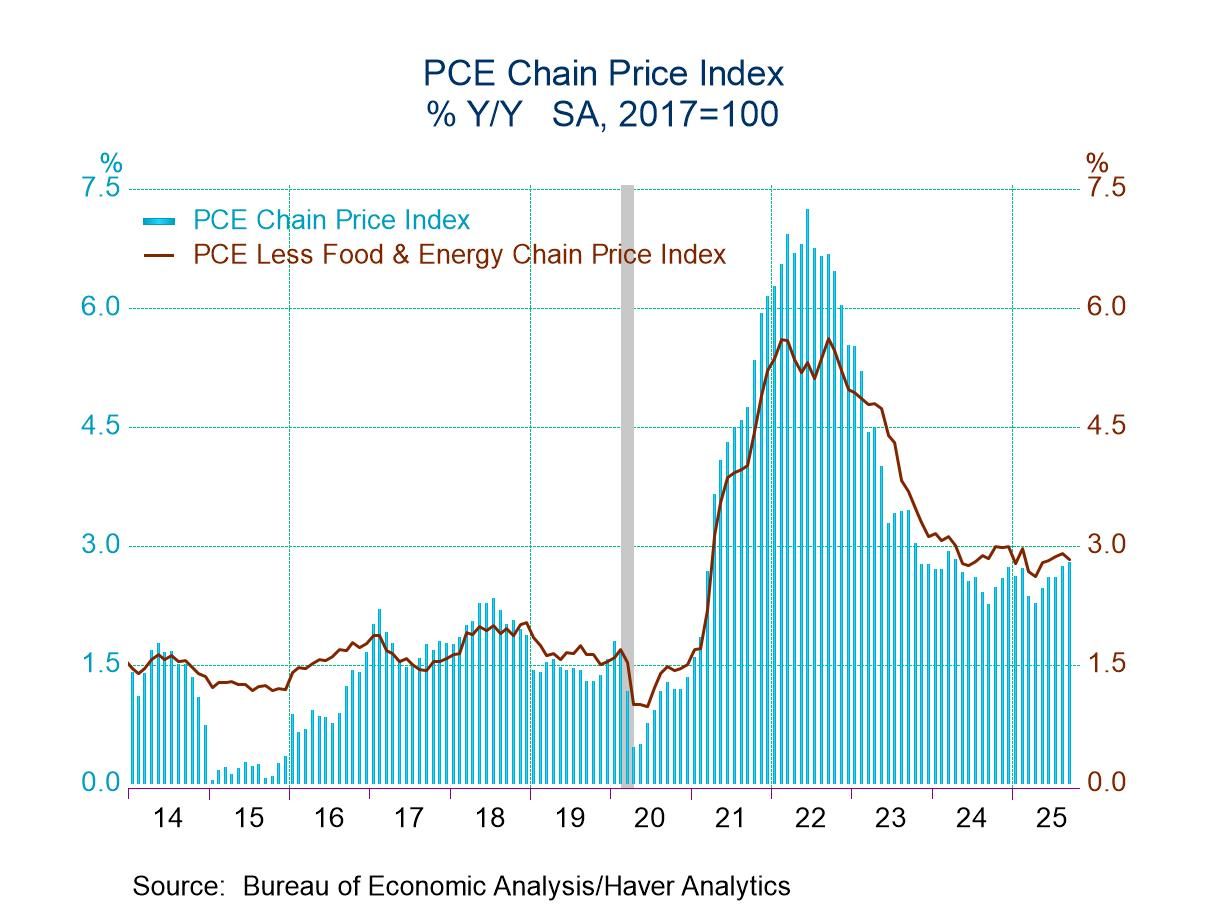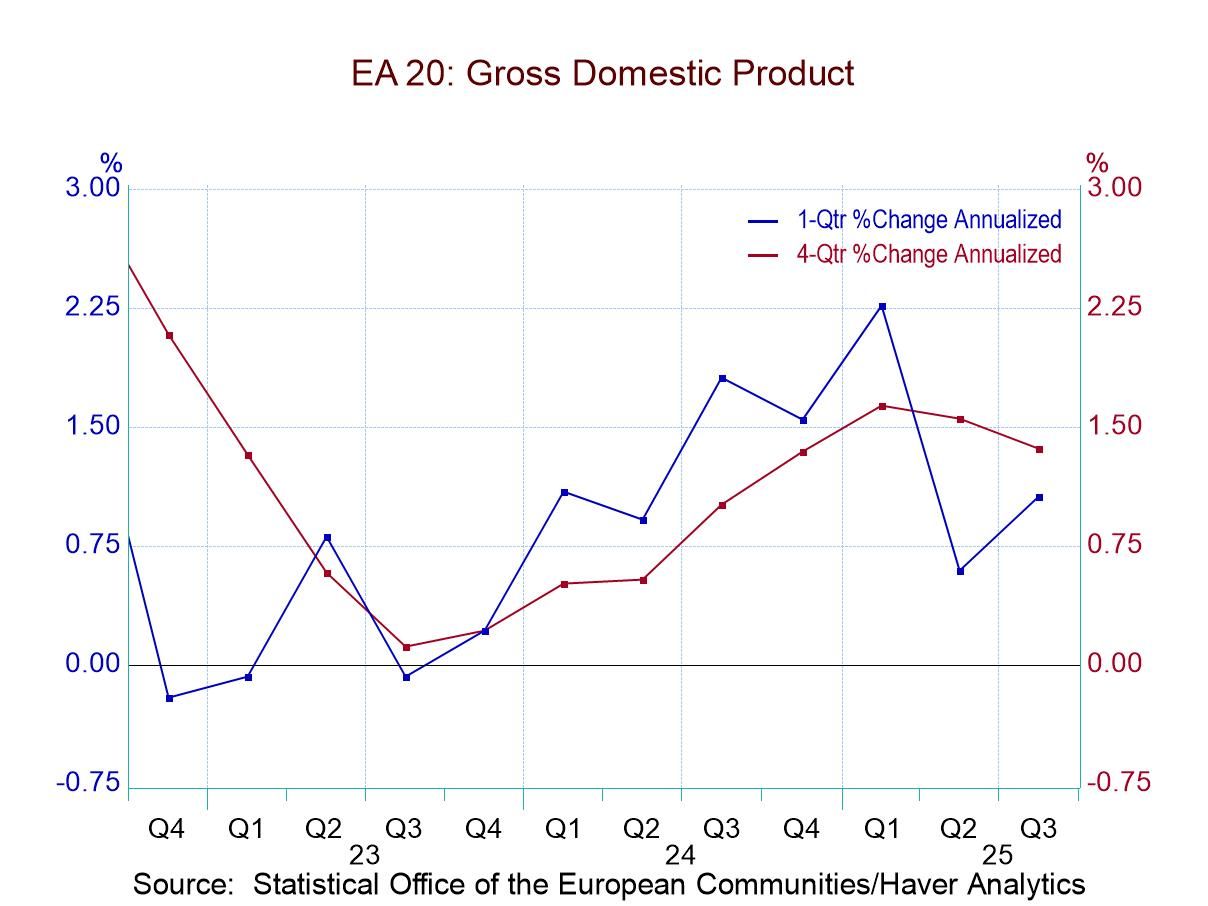 Global| Apr 27 2021
Global| Apr 27 2021Italy's Consumer Confidence Remains Shaken, But Stirs
Summary
Consumer confidence in Italy (NSA) fell back in April to 98.1 from 101.7 in March for its second monthly decline in a row. The confidence gauge is lower on a net basis over three months as well as over 12 months. Its April level of [...]
 Consumer confidence in Italy (NSA) fell back in April to 98.1 from 101.7 in March for its second monthly decline in a row. The confidence gauge is lower on a net basis over three months as well as over 12 months. Its April level of 98.1 compares to an historic average value of 103. The April level has a rank standing in the queue of historic data at its 25.8 percentile, at the borderline of the bottom 25% of its historic queue of data. As such, the reading lies well below its mean and median (the median is located at a queue standing of 50%). Consumer confidence in Italy continues to struggle and while business confidence has improved, consumer confidence continues to lag behind and show none of the recent lift business confidence has experienced. But the consumer gauge has stabilized… in a range. Some components are actually quite strong.
Consumer confidence in Italy (NSA) fell back in April to 98.1 from 101.7 in March for its second monthly decline in a row. The confidence gauge is lower on a net basis over three months as well as over 12 months. Its April level of 98.1 compares to an historic average value of 103. The April level has a rank standing in the queue of historic data at its 25.8 percentile, at the borderline of the bottom 25% of its historic queue of data. As such, the reading lies well below its mean and median (the median is located at a queue standing of 50%). Consumer confidence in Italy continues to struggle and while business confidence has improved, consumer confidence continues to lag behind and show none of the recent lift business confidence has experienced. But the consumer gauge has stabilized… in a range. Some components are actually quite strong.
Business confidence fares better
In contrast, business confidence has risen to 105.4 in April from 107.7 in March. It is up on balance over three months and over 13 months (the 12-month ago figure is missing' because the survey was not conducted in the height of the Covid-19 crisis). The percentile standing of the business reading is in its 69.9 percentile, a respectably firm reading.
Business confidence makes ongoing gains and the consumer flat-lines
What we see is evidence that businesses are gaining confidence much faster than individuals. In fact, businesses are gaining confidence rather rapidly while consumers show a sharp and short-lived increase in confidence from its depths followed by a flat-lining at a relatively low level.
The last 12-months: The worst ever
The values in the table show that the assessment of the overall situation is the lowest ever on this timeline at a -153 reading. The mean response historically is at -80. The standing, of course, is the worst ever. So consumers when they are comparing circumstances now with the last 12-months are comparing them to the worst situation they think they ever have faced.
From famine to feast?
Maybe it is not surprising that over the next 12-months, consumer assessments expect the overall situation to be much better, assessing it at a level that garners a 92nd percentile historic rank standing (only 8 percentile points off the all-time highest mark; it is the 19th highest assessment on this timeline).
...to conundrum
However, at the same time unemployment prospects are evaluated as high with a standing at its 89th percentile. I guess this means that while the potential for unemployment remains quite high, workers expect to continue to be cared for by their government. That would explain the high assessment of the overall situation, assessed on the same timeline, even though unemployment was considered a real threat. The household budget for 12 months ahead is assessed as better, moving it to a 76th percentile standing.
Household financial situation
In keeping with this speculation about what these responses mean, over the last 12-months, the household financial situation is only assessed at a 49.7 percentile standing nearly on top of its historic median. This is despite the worst overall situation experienced ever over the same past 12-months. Respondents clearly are acknowledging the help provided by the government in their assessment. As for the period looking ahead, the assessment rises to -2 from -7 last month, above its historical mean value at -5 to a rank percentile standing at 66% at the border of the top third among all historic results. However, since respondents incorporate government help into their responses and since assistance is continuing, we do not get a very good read on what consumers expect for the economy per se. They do seem to feel that the end result of economic performance and government assistance will be adequate.
The savings barometer
Current and future household savings responses did not change much month-to-month or even over the last four months. Current savings prospects have a 68th percentile standing compared to a 95th percentile standing for future savings. It is unclear in these circumstances whether future savings prospects amid such uncertainly about economic growth and the behavior of the virus should be so high. Possibly it reflects a belief that there will be Covid-19 assistance monies paid out indiscriminately that will boost savings of those who are not adversely impacted by Covid-19 as well as to those who might need support payments.
Major purchases
In any event, Italians, ever the optimists, see some slight slippage in major purchase conditions in April compared to January and February but hold to a high evaluation nonetheless. The ranking of the April response is in its 88th queue percentile- a high reading.
Crosscurrents in confidence
On balance, the take on consumer confidence offers us some baffling clues as to what the Italian consumer is thinking or expecting. In truth, we cannot from this survey unravel the expectations for the economy from the expectations for continuing government help in the future. The relatively high expectations for unemployment contrast and clash with a smiling evaluation of the expected economic situation with both evaluated over the next 12-months.

Summing up
The fact is that no one knows how the future will unfold. The terrible outbreak of the virus in India and the ongoing death toll in Brazil both are chilling reminders of the ongoing threat. They are also reminders that the virus needs to be eradicated everywhere or it will find a spot to thrive and perhaps mutate into something more lethal. Still, that fear is probably an outlier. Most virologists don't seem to see that as a 'base case' since the virus that becomes more lethal and kills its host cannot be so easily spread. This is why viruses usually mutate to more benign forms. The U.S. has just announced that is going share a large complement of vaccine with other countries. For now the vaccine spread in the U.S. is incredibly well contained despite the escalation in state of Michigan. The U.S. CDC director who a few weeks ago confessed to a feeling of 'impending doom' as several states began to open up more, was dead wrong. It may be that in the U.S. the CDC 'scare tactics' are no longer going to work. But in some countries where the risk of contagion may still be quite high and where the lethality of the virus may be more of a concern there may be a need for ongoing caution and action. The pandemic seems to be receding into a series of local outbreaks of varying severity that will need their own special attention. Still, the risk to the global economy is always there as a potential either from a sprouting of Covid-19 or from whatever is next. We have seen what it can do. It's a new world. It will require new and better preparations.
Robert Brusca
AuthorMore in Author Profile »Robert A. Brusca is Chief Economist of Fact and Opinion Economics, a consulting firm he founded in Manhattan. He has been an economist on Wall Street for over 25 years. He has visited central banking and large institutional clients in over 30 countries in his career as an economist. Mr. Brusca was a Divisional Research Chief at the Federal Reserve Bank of NY (Chief of the International Financial markets Division), a Fed Watcher at Irving Trust and Chief Economist at Nikko Securities International. He is widely quoted and appears in various media. Mr. Brusca holds an MA and Ph.D. in economics from Michigan State University and a BA in Economics from the University of Michigan. His research pursues his strong interests in non aligned policy economics as well as international economics. FAO Economics’ research targets investors to assist them in making better investment decisions in stocks, bonds and in a variety of international assets. The company does not manage money and has no conflicts in giving economic advice.






